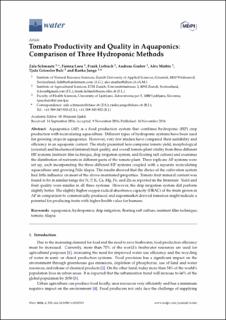Please use this identifier to cite or link to this item:
https://doi.org/10.21256/zhaw-1602| Publication type: | Article in scientific journal |
| Type of review: | Peer review (publication) |
| Title: | Tomato productivity and quality in aquaponics : comparison of three hydroponic methods |
| Authors: | Schmautz, Zala Loeu, Fionna Liebisch, Frank Graber, Andreas Mathis, Alex Griessler Bulc, Tjasa Junge, Ranka |
| DOI: | 10.21256/zhaw-1602 10.3390/w8110533 |
| Published in: | Water |
| Volume(Issue): | 8 |
| Issue: | 11 |
| Issue Date: | 2016 |
| Publisher / Ed. Institution: | MDPI |
| ISSN: | 2073-4441 |
| Language: | English |
| Subjects: | Aquaponics; Tomato yield; Hydroponic |
| Subject (DDC): | 630: Agriculture |
| Abstract: | Aquaponics (AP) is a food production system that combines hydroponic (HP) crop production with recirculating aquaculture. Different types of hydroponic systems have been used for growing crops in aquaponics. However, very few studies have compared their suitability and efficiency in an aquaponic context. The study presented here compares tomato yield, morphological (external) and biochemical (internal) fruit quality, and overall tomato plant vitality from three different HP systems (nutrient film technique, drip irrigation system, and floating raft culture) and examines the distribution of nutrients in different parts of the tomato plant. Three replicate AP systems were set up, each incorporating the three different HP systems coupled with a separate recirculating aquaculture unit growing Nile tilapia. The results showed that the choice of the cultivation system had little influence on most of the above-mentioned properties. Tomato fruit mineral content was found to be in similar range for N, P, K, Ca, Mg, Fe, and Zn as reported in the literature. Yield and fruit quality were similar in all three systems. However, the drip irrigation system did perform slightly better. The slightly higher oxygen radical absorbance capacity (ORAC) of the fruits grown in AP in comparison to commercially produced and supermarket derived tomatoes might indicate a potential for producing fruits with higher health value for humans. |
| URI: | https://digitalcollection.zhaw.ch/handle/11475/2364 |
| Fulltext version: | Published version |
| License (according to publishing contract): | CC BY 4.0: Attribution 4.0 International |
| Departement: | Life Sciences and Facility Management |
| Organisational Unit: | Institute of Natural Resource Sciences (IUNR) |
| Appears in collections: | Publikationen Life Sciences und Facility Management |
Files in This Item:
| File | Description | Size | Format | |
|---|---|---|---|---|
| 2016_Schmautz_Tomato productivity and quality in aquaponics_Water.pdf | 4.55 MB | Adobe PDF |  View/Open |
Show full item record
Schmautz, Z., Loeu, F., Liebisch, F., Graber, A., Mathis, A., Griessler Bulc, T., & Junge, R. (2016). Tomato productivity and quality in aquaponics : comparison of three hydroponic methods. Water, 8(11). https://doi.org/10.21256/zhaw-1602
Schmautz, Z. et al. (2016) ‘Tomato productivity and quality in aquaponics : comparison of three hydroponic methods’, Water, 8(11). Available at: https://doi.org/10.21256/zhaw-1602.
Z. Schmautz et al., “Tomato productivity and quality in aquaponics : comparison of three hydroponic methods,” Water, vol. 8, no. 11, 2016, doi: 10.21256/zhaw-1602.
SCHMAUTZ, Zala, Fionna LOEU, Frank LIEBISCH, Andreas GRABER, Alex MATHIS, Tjasa GRIESSLER BULC und Ranka JUNGE, 2016. Tomato productivity and quality in aquaponics : comparison of three hydroponic methods. Water. 2016. Bd. 8, Nr. 11. DOI 10.21256/zhaw-1602
Schmautz, Zala, Fionna Loeu, Frank Liebisch, Andreas Graber, Alex Mathis, Tjasa Griessler Bulc, and Ranka Junge. 2016. “Tomato Productivity and Quality in Aquaponics : Comparison of Three Hydroponic Methods.” Water 8 (11). https://doi.org/10.21256/zhaw-1602.
Schmautz, Zala, et al. “Tomato Productivity and Quality in Aquaponics : Comparison of Three Hydroponic Methods.” Water, vol. 8, no. 11, 2016, https://doi.org/10.21256/zhaw-1602.
Items in DSpace are protected by copyright, with all rights reserved, unless otherwise indicated.